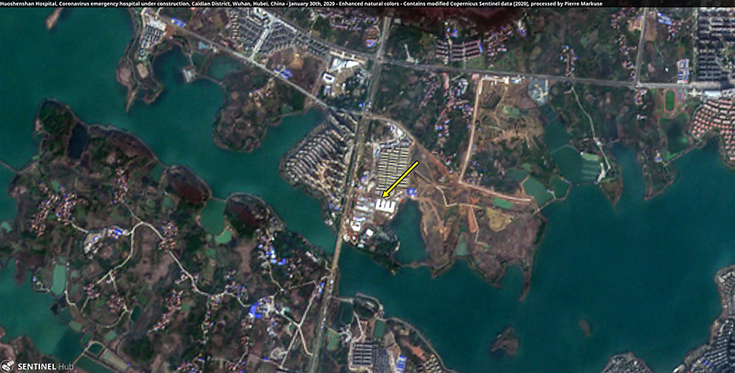Wuhan: Hospital completed in ten days
Replicating its SARS treatment model of 2003, China has built a makeshift hospital with a capacity of 1,000 beds in 10 days. Huoshenshan (which means Fire God Mountain) Hospital in Wuhan, where the virus broke out, is dedicated to treating patients infected with 2019 novel coronavirus (2019-nCoV). A total of 1,400 medical staff from the armed forces are tasked with treating patients in Huoshenshan Hospital starting from Monday, February 3, 2020.

Huoshenshan Hospital, Coronavirus emergency hospital under construction, Caidian District, Wuhan, Hubei, China - January 30th, 2020 (Contains modified Copernicus Sentinel data [2020], processed by Pierre Markuse. Reproduced under CC licence)
The 2019-nCoV has spread to 24 more countries, with 14,549 confirmed cases of infection.
Three hundred and five deaths, including one in the Philippines, were reported across the world as of February 1, 2020, and 328 people had recovered and been discharged from hospital in China.
Worryingly, cases of human-to-human transmission are confirmed to have happened outside Wuhan and outside China.
The WHO held a second meeting of the Emergency Committee regarding the outbreak of 2019-nCoV in the People’s Republic of China on January 30, 2020.
The WHO Committee welcomed the leadership and political commitment of the very highest levels of Chinese government, their commitment to transparency, and the efforts made to investigate and contain the current outbreak. In a statement, it said: “China quickly identified the virus and shared its sequence, so that other countries could diagnose it quickly and protect themselves, which has resulted in the rapid development of diagnostic tools.”
Previous Report:

On January 27, Chinese Premier Li Keqiang visited Wuhan, the capital of Hubei province and centre of the outbreak. The number of deaths in Hubei has risen from 56 to 76, with five deaths elsewhere. Wuhan is in lockdown and several other cities have imposed travel bans. Image: vampy1|123rf. Thumbnail: chrupka|123rf
In Shanghai, the BBC reports that the government has stopped businesses from returning to work until February 10. The ban applies to all companies apart from utilities, medical firms, medical suppliers, and supermarkets. Meanwhile, the director-general of the World Health Organisation, Tedros Adhanom Ghebreyesus, has travelled to Beijing to discuss the outbreak with the Chinese government and health experts.
Coronavirus cases
So far there have been 2,827 confirmed cases with 5,794 suspected cases, 461 of whom are in a critical condition, according to the National Health Commission and state media as of January 26. Fifty-one people are reported to have recovered and been discharged from hospital. At least 44 cases have been confirmed abroad, including in Thailand, the United States, and Australia. There have been no deaths outside China. Most of the 81 deaths have been of elderly people or those with pre-existing respiratory problems.
Wuhan’s hospitals
The BBC reports that the emergency has overwhelmed Wuhan's hospitals. More than half a million medical staff have joined prevention, control and treatment operations in the province. Two new makeshift hospitals are being built in the city and factories are rushing to produce masks and protective clothing. On January 27, Premier Li inspected the ongoing efforts, and spoke to patients and medical staff, a government statement said.
New year celebrations have been scaled back and four major cities - Beijing, Shanghai, Xian and Tianjin – have reportedly banned long-distance buses. The Forbidden City in Beijing has been closed to tourists, as has a part of the Great Wall, and both Disney parts in Hong Kong and Shanghai have been closed. Schools and official institutions will remain closed for the rest of this week as the new year holiday is extended to February 2.
Hong Kong, which has eight confirmed cases, has declared a city-wide emergency, with schools closed until February 17. Mongolia - which has yet to record a case of the virus - has closed its border with China. It has also closed schools until March 2, and banned public events.
He Qinghua, a top official with China's National Health Commission, told reporters that some areas still lack determination in controlling the epidemic, according to the state-run newspaper Global Times. He said that rural villages, in particular, were failing to deal with the crisis "in a timely manner".
Over the weekend, Chinese officials warned that the virus was able to spread during its incubation period, making it harder to contain the illness. In humans, the incubation period - during which a person has the disease, but no symptoms - ranges from between one and 14 days, officials believe.
Staying safe
In Beijing, subway carriages are being disinfected once a day, while escalators and ticket machines are being disinfected three times a day. The city of Tianjin, near Beijing, has asked taxi drivers to disinfect vehicles after every passenger.
For individuals, the WHO advises its ‘standard recommendations’ focusing on "hand and respiratory hygiene". This essentially means washing hands or using disinfectants, and covering one's mouth and nose when coughing or sneezing. The advice also suggests avoiding contact with live animals in places where there have been coronavirus cases, and not to eat raw or uncooked animal products.
Read the full story here
Reproduced under licence from BBC News © 2020 BBC